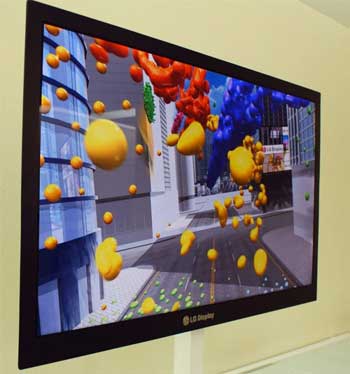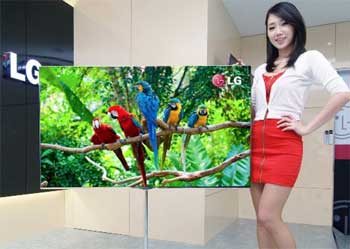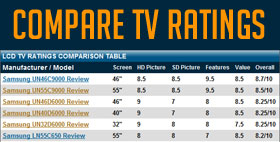WSJ Piece on Thinner OLED Televisions/Fatter Profits CES 2012 LG, Sony; Robert Wiley Responds
by Robert Wiley
 Having covered televisions for a dozen years now, both in reviews and reporting on new developments in the industry, for a dozen years – I felt compelled to chime in on the the recent piece by the Wall Streen Journal titled, "TV Makers Seek Fatter Profits in Thinner Sets." First let's take a step back in time to the introduction of a very expensive Television technology that naysayer's stated would not sell, Plasma Televisions. When they were introduced to the consumer market in 1999 and 2000 and for a couple of years thereafter, plasma televisions were called "Gas Plasma Displays," and they were too expensive for anyone to afford. A 42" plasma cost $15,000 when they were first introduced. The important aspect of the buy sell equation was that people really wanted them. Badly. Why? They were an entirely different entity than the large square box sitting in your living room. They processed the signal differently, the picture looked different, but most importantly they brought a modern attribute to the television similar to the one we just experienced in the last few years with touch screen smart phones and the iphone. They got the television out of the previously needed armoire and onto the wall or positioned on a slim table stand. This attribute was a considerable wife-pleasing space saver.
Having covered televisions for a dozen years now, both in reviews and reporting on new developments in the industry, for a dozen years – I felt compelled to chime in on the the recent piece by the Wall Streen Journal titled, "TV Makers Seek Fatter Profits in Thinner Sets." First let's take a step back in time to the introduction of a very expensive Television technology that naysayer's stated would not sell, Plasma Televisions. When they were introduced to the consumer market in 1999 and 2000 and for a couple of years thereafter, plasma televisions were called "Gas Plasma Displays," and they were too expensive for anyone to afford. A 42" plasma cost $15,000 when they were first introduced. The important aspect of the buy sell equation was that people really wanted them. Badly. Why? They were an entirely different entity than the large square box sitting in your living room. They processed the signal differently, the picture looked different, but most importantly they brought a modern attribute to the television similar to the one we just experienced in the last few years with touch screen smart phones and the iphone. They got the television out of the previously needed armoire and onto the wall or positioned on a slim table stand. This attribute was a considerable wife-pleasing space saver.
The above referenced and well written Wall Street Journal piece begins like this: "SEOUL—Television manufacturers, stung by steep profit declines this year, will start making TV sets that are even thinner and lighter in hopes of seeking new consumer interest and driving average prices higher." It goes on to mention a 55" LG OLED Television that will actually be for sale in 2012 that is much thinner and lighter than current televisions in the market. Our best guess is that LG will not be the only manufacturer displaying OLED Televisions this year. The once laid-out-for-dead technology is back and is new and improved in many ways. We have always been fans of OLED, in fact designating the autostereoscopic 3D Sony OLED TV from CES 2011 Best in Show of all televisions displayed.
 The tough question for me is this; "Haven't flat screen televisions been getting thinner and lighter for the past 10 years?" Yes, they have. So why all of a sudden will people be willing to pay between $4000 to $8000 for these new OLED Televisions. The answer is obvious, they wont. Consumers are not good-hearted enough in 2012 to want to overpay significantly for a TV technology that so marginally improves their viewing experience. Why? Because the thinner and lighter Televisions that will be produced with this new technology will be a significant margin less better than the trans formative improvement offered when flat screen plasma televisions invaded the TV landscape. That was a huge improvement in lifestyle change, status change, viewing change and space savings.
The tough question for me is this; "Haven't flat screen televisions been getting thinner and lighter for the past 10 years?" Yes, they have. So why all of a sudden will people be willing to pay between $4000 to $8000 for these new OLED Televisions. The answer is obvious, they wont. Consumers are not good-hearted enough in 2012 to want to overpay significantly for a TV technology that so marginally improves their viewing experience. Why? Because the thinner and lighter Televisions that will be produced with this new technology will be a significant margin less better than the trans formative improvement offered when flat screen plasma televisions invaded the TV landscape. That was a huge improvement in lifestyle change, status change, viewing change and space savings.
To stratify my point, one of the positive traits being touted by the "new" OLED televisions is a wide color gamut allowing for very wide viewing angles. So how much of an improvement is this? Well, over plasma technology it is not an improvement at all since plasma televisions are also composed of individually lit pixels like OLED TVs and therefore have perfect side viewing angle performance. And what about the significantly improved contrast of OLEDs? Yes, the contrast is better but there is lots of debate about what the eye can actually even perceive in contrast so going from 2000:1 to 10,000:1 in contrast ratio is barely perceptible to most people.
OK let's then look at the thinner, lighter concept mentioned. Is going from a 1 inch panel to a .3" panel and thus saving that .7" a big difference to you? No, of course not. They are both exceptionally "out-of-the-way" in your living room space. The wall mounting bracket or table top stand would make far more difference in the depth equation. The weight? I dont know about you, but I don't carry my TV around with me but once every 5 years when I move. Energy savings? Give me a break, save 10 bucks a year in energy savings?
Will some consumers purchase this new technology? Yes, there are always some early adopters that will purchase "bling" products like this to show off, or others that just have to have the latest and greatest. But in the end, the high price and marginal utility increase will lead to disappointment for the major television manufacturers – once again. Even most well heeled consumers will not be willing to depart with an extra $5000 for a 55" Television. The real problem with the manufacturer's ability to make money is obvious. They are engaged in hyper competition among each other for market share. Since the manufacturers from Japan, Korea, and soon-to-come China cannot collude, they must consolidate. This is the wave of the future more than new technologies like OLED. Pioneer's departure from the TV business is a stark example.
Now ask me if I want one of these new Sony, Samsung or LG OLED TVs that we will see next week at CES 2012... Yes, you're darn right I want one! Badly.




